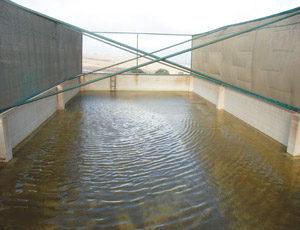Oman plans to generate thousands of liters of water a day thanks to a budding technology that collects and stores fog droplets.

In the second year of a five-year “fog collection project,” Omani officials, in collaboration with Japan’s Mitsubishi Corp., have placed large nets made of plastic mesh at about 700 meter above sea level in the Al Qara mountains near Salalah, in the southern part of the nation.
The collector is comprised of four 20-m-wide, 3-m-tall nets at opposite ends of a reservoir capable of holding 400 cu m of water. As fog from the summer monsoon, or “khareef,” rolls in, droplets are captured on the mesh. They will drip down into the reservoir to be stored and used as needed.
Mitsubishi is donating materials and technical expertise valued at about $370,000 to the project, as part of its corporate sustainability program.
The water will irrigate plantings to reverse four decades of desertification in parts of Salalah. Collected droplets can also be used as drinking water for animals. By the project’s end in 2013, organizers hope to have created a 4-km-long greenbelt of about 1,000 trees.
“The next step is to convince communities to use this technique and use the water to wash clothes or for animals, instead of buying water,” says Ali Ahmed Al Kiyumi, the director general of natural conservation at the Omani Ministry of Environment and Climate.
Mitsubishi spent the first half of 2009 constructing and erecting the mesh nets and building the reservoir in time for last year’s monsoon. But a weaker-than-expected khareef last year produced only about 200 cu m of water. “This year, the monsoon is already stronger, so we expect 400 cubic meters,” says Tomoo Shoji, Mitsubishi’s environmental specialist for the project.
Even with weak rainfall, the group was able to irrigate new plantings of 250 indigenous trees on what had been barren landscape. The greenbelt is fenced off to keep animals from grazing on the plants.
The fog collection project is the first for the largely arid Arabian peninsula. Oman faces the Arabian Sea and benefits from the annual monsoons that wash over the Indian subcontinent. Salalah is especially lush, with fog rolling in over the mountains before evaporating inland in the Rub al Khali desert.
Robert Schemenauer, executive director of Fogquest, says fog collection programs are a reliable source of water because large-scale weather patterns don’t normally change for thousands of years. The Canadian nonprofit, based in Kamloops, B.C., plans and implements fog collection projects in rural communities of developing countries.
“Once you set up a project like this you can expect the water to come, basically forever,” Schemenauer says.
Though fog collection initiatives could work in more urban areas, such as parts of California, Schemenauer says communities with more resources are likely to build larger-scale projects. These include desalination plants.
Fog collection projects have been initiated in Chile and Ecuador in South America and Eritrea in northeastern Africa. Fog collector nets installed in Falda Verde, Chile, in 2001, were replaced last year. That program continues to produce 600 l of water each day, and irrigates greenhouses and an aloe vera farm.
Supporters of the Oman project hope for a similar outcome. “Once the trees have grown, they themselves will function as ‘live mist catchers’ to produce water for the area,” Shoji says.

Post a comment to this article
Report Abusive Comment